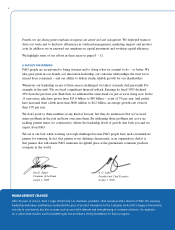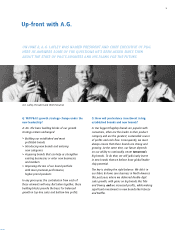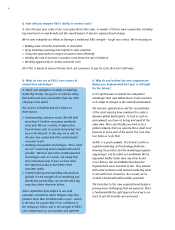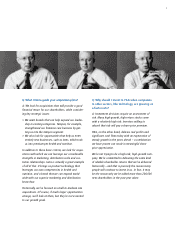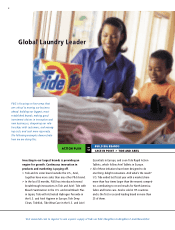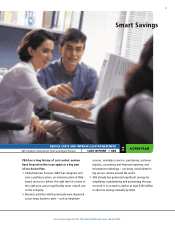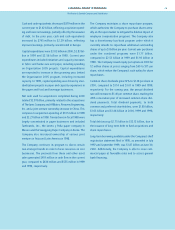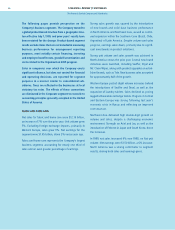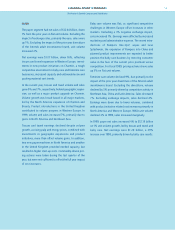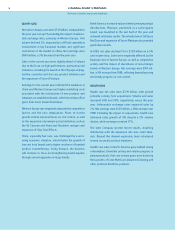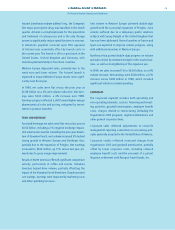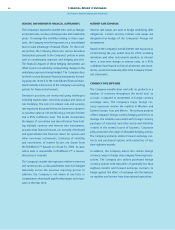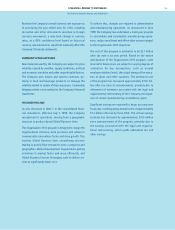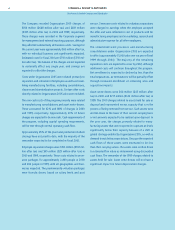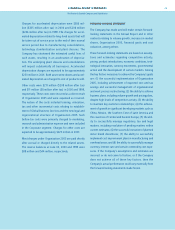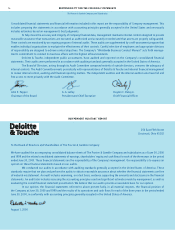Proctor and Gamble 2000 Annual Report Download - page 16
Download and view the complete annual report
Please find page 16 of the 2000 Proctor and Gamble annual report below. You can navigate through the pages in the report by either clicking on the pages listed below, or by using the keyword search tool below to find specific information within the annual report.
FINANCIAL REVIEW (CONTINUED)
The Procter & Gamble Company and Subsidiaries
14
The following provides perspective on the year ended
June 30, 1999, versus June 30, 1998:
Worldwide net earnings were $3.76 billion in 1999, flat
versus $3.78 billion in 1998.
Worldwide net sales in 1999 were $38.13 billion, up
3% from $37.15 billion in the prior year on flat unit vol-
ume. The increase in sales was attributable to improved
pricing in all regions and favorable volume and product
mix in North America, partially offset by exchange
impacts. Unfavorable exchange rates, primarily in Asia
and Latin America, depressed sales by 1% for the year.
Worldwide gross margin increased to 44.8% from 43.8%
in 1998, reflecting effective cost savings, primarily in
North America. Organization 2005 charges increased
cost of products sold by $443 million in 1999, as a result
of asset write-downs and accelerated depreciation.
Excluding these charges, gross margin increased to 46.0%.
Worldwide marketing, research and administrative
expense was 28.4% of net sales, compared with 27.5%
in 1998. The 6% increase in total spending was primarily
due to increased research spending, primarily in the
paper and health care businesses, and increased spend-
ing for new initiatives. Organization 2005 charges
increased marketing, research and administrative
expense by $38 million, related primarily to employee
separation expenses.
Operating income grew 3% in 1999. Excluding the
charges for Organization 2005, operating income grew
11%. These trends reflected sales growth and cost
control efforts. Net earnings margin was 9.9% in 1999
versus 10.2% in 1998. Excluding the Organization 2005
charges, core net earnings margin in 1999 was 10.9%,
the highest in 58 years.
Interest expense increased 19% to $650 million in 1999, on
increased debt, due mainly to share repurchases. In 1998,
interest expense was $548 million. Other income, net,
was $235 million in 1999, versus $201 million in 1998.
The Company’s effective tax rate for the year was 35.5%,
compared to 33.8% in 1998. The increase reflected a
reduction in benefits for research and development tax
credits in North America, which were included in 1998
results, as well as the impact of various country tax
rates on Organization 2005 program costs. Excluding
Organization 2005 program costs and related tax effects,
the tax rate was 34.4%.
Over the last several years, the Company maintained
an ongoing program of simplification and standardiza-
tion, which included projects to consolidate selected
manufacturing facilities, re-engineer manufacturing and
distribution processes, redesign organizations, simplify
product line-ups and divest non-strategic brands and
assets. This program did not have a significant impact
on 1999 or 1998 net earnings. Beginning with the
fourth quarter of 1999, the restructuring aspects of this
program were superseded by Organization 2005.
Certain reclassifications of the prior years’ amounts
have been made to conform with the current year
presentation.
FINANCIAL CONDITION
Cash flow from operations was $4.68 billion, $5.54 billion
and $4.89 billion in 2000, 1999 and 1998, respectively.
Operating cash flow provided the primary source of funds
to finance operating needs, capital expenditures and
shareholder dividends. Supplemented by additional
borrowings, cash flow from operations also provided funds
to finance acquisitions and the share repurchase program.


